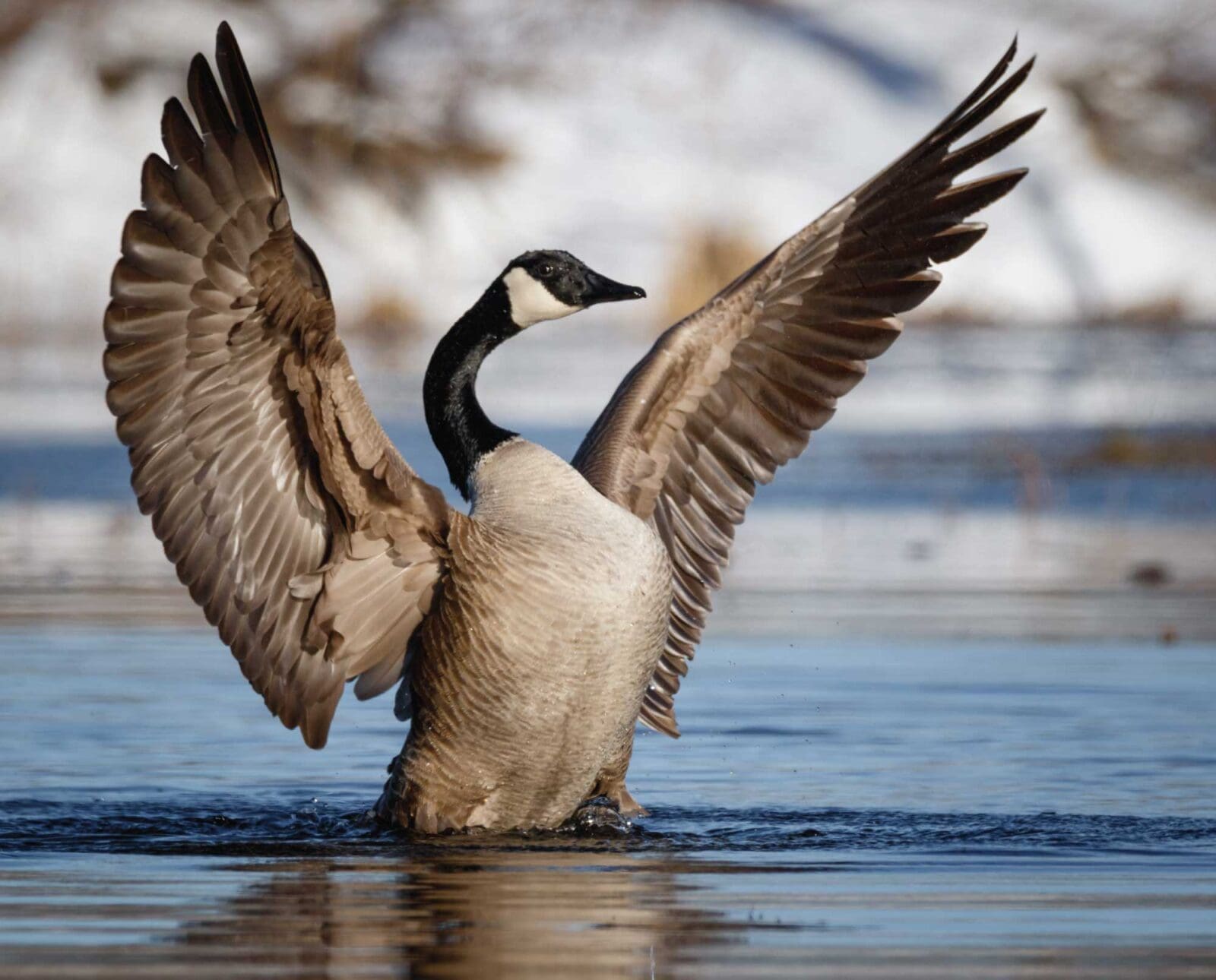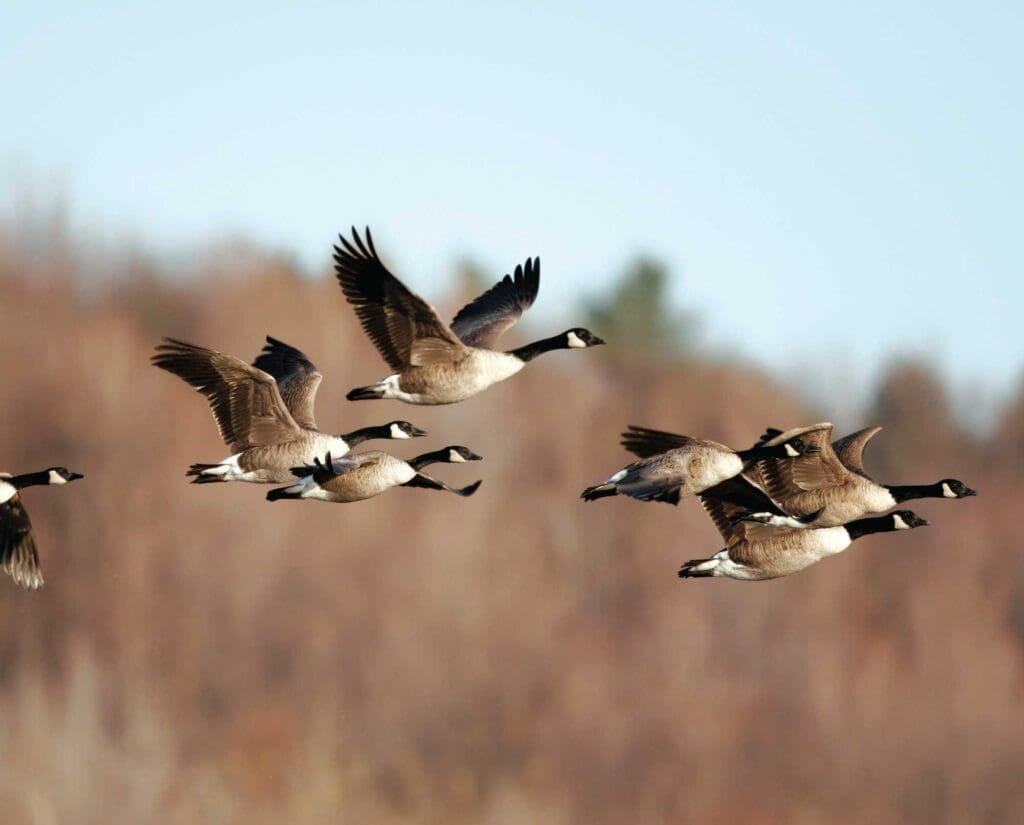Home » Waterfowl Hunting » Canada Goose (Branta canadensis)
Canada Goose (Branta canadensis)

Ryan Lisson is a biologist and regular content contributor to…
Breaking Down the Stigma Behind the Canada Goose
The Canada goose (Branta canadensis) is just one of those birds you hate to love or love to hate. They’re often seen as an aggressive, nuisance animal at golf courses, parks, and beaches, and most people have plenty of jokes about how bad they taste. With such nicknames as “flying rats” or “sky carp,” you don’t exactly get the same warm, fuzzy feeling as you do from wood ducks, right? But is all of that stigma really fair? This resilient and hardy bird, also called a “honker” by many, is common around most of North America throughout the year.
There are several sub-species of the Canada goose depending on which region they live in, which can be confusing. Tundra sub-species tend to be smaller, while southern ones are typically larger (NatureServe 2018). Likewise, West Coast sub-species tend to be darker in coloration than eastern ones. Some examples of these sub-species include the true Canada goose (which this article discusses), Vancouver Canada goose, dusky Canada goose, lesser Canada goose, Aleutian Canada goose, cackling Canada goose, and Taverner’s Canada goose. Here’s some more information about this interesting waterfowl species that you might not have known.
Description and Life History of the Canada Goose
The Canada goose is a very large bird if you’re primarily used to hunting ducks. Most individuals measure about 29 to 45 inches in length and weigh anywhere from 7 to 20 pounds (All About Birds 2018; NatureServe 2018). They have a large body, muscular wings and a long neck. But their most conspicuous identifying feature is their coloration, which is nearly identical between males and females. Their necks and heads are black with a white cheek/chin strap. The feathers on the body are dark brown on top, fading to creamy white on the underside. Although their tail feathers are black, they have a bright white U-shaped ring of feathers on the upper side (All About Birds 2018). Their bills and feet are dark gray to black in color. Males tend to be slightly larger than females, but that’s about the only difference between them. Of course, the best way to identify them is by their loud nasally honking noise, which you’re almost certainly familiar with.
Canada goose pairs usually mate for life, and males will defend their summer breeding territories and nest sites (National Audubon Society 2018). Generally, these geese defend themselves by lowering their head, hissing, spreading their wings, and charging at rivals, predators, or humans. Females choose the nest site, which is typically located on a slightly elevated spot with good visibility near water, such as a muskrat mound, rocky ledge, or nesting platform (All About Birds 2018; National Audubon Society 2018). The nest is usually bowl-shaped and constructed of sticks and grass; the female then lines it with her own downy feathers. She typically lays 2 to 11 creamy white eggs and incubates them by herself for about 25 to 30 days (National Audubon Society 2018; NatureServe 2018). After 1 or 2 days, the male and female will lead them away from the nest and tend them, although the hatched goslings can feed themselves. The goslings can fly at 7 to 9 weeks, but they typically stay with their parents until the following spring (All About Birds 2018; National Audubon Society 2018). Over the summer, family groups will start to gather and form larger flocks leading up to the fall migration. Over the winter, they are often seen in very large flocks near water sources.
The Canada goose feeds much like dabbling ducks, such as the mallard, usually by floating in the water and dipping its head underwater to graze on plants and seeds (National Audubon Society 2018). However, they will also happily graze like a cow on lawns and in fields. They tend to seek out seeds, berries, leaves, stems, and shoots from several plants, including sedges, grasses, clover, cattails, bulrushes, pondweed, skunk cabbage, and eelgrass (National Audubon Society 2018, All About Birds 2018; NatureServe 2018). They also eat insects, crustaceans, mollusks, and small fish and will quickly consume grain (e.g., wheat, corn, etc.) in cultivated fields.
Adult geese are fairly aggressive toward most predators, but are still occasionally susceptible to predation. The biggest threat is to eggs, goslings, and incubating females. Raccoons, skunks, foxes, coyotes, bobcats, gulls, ravens, and raptors (mostly eagles) all commonly prey on the Canada goose at some point throughout its life cycle (Washington Department of Fish and Wildlife 2018).

Range and Habitat of the Canada Goose
The Canada goose occupies a large range in North America, breeding from Alaska across northern Canada in the summer and migrating as far south as northern Mexico in the winter (NatureServe 2018). Many populations may stay year-round in the lower 48 states provided there are open water and food sources available (National Audubon Society 2018). Populations have also been introduced in Europe and New Zealand.
The Canada goose can live in several habitat types across their great range. Lakes, ponds, marshes, pastures, grain fields and tundra can all be home to a goose, provided there is water nearby (National Audubon Society 2018). As mentioned earlier, geese are particularly fond of lawns and large grassy fields, likely because they provide a lush food source and the geese can detect predators very easily (and most lawns have very few natural predators anyway).
Conservation Issues for the Canada Goose
Not surprisingly, the Canada goose is listed as globally secure and of Least Concern by the IUCN Red List (NatureServe 2018). The 2015 North American population was estimated to be between 4.2 million and 5.6 million birds (All About Birds 2018).
The abundance of lawns, parks, and golf courses has likely increased the population over time, due to the food and security of nesting near humans. However, they have become nuisance animals in many places due to this habit. Many municipal governments routinely remove them for fouling beaches (causing E. coli outbreaks) or parks with their abundant scat. Near airports, they are also a legitimate safety hazard for the very real threat of collisions with aircraft. Around 2.6 million geese are harvested in North America each year, but populations appear to be unaffected (All About Birds 2018).
Hunting Opportunities for the Canada Goose
Now it’s time to address the hunting stereotypes associated with these honkers. I don’t think anyone can argue how fun they are to hunt. When you get a large flock flying over you, it is sheer excitement. Though many people say they don’t like the taste of geese, that’s probably just because they don’t know how to cook them. Goose can be wonderful if prepared the right way. Here are a few tips on hunting equipment you’ll need and how to hunt them.
Equipment and Bag Limits
Geese are big birds, especially if you’re targeting the big southern sub-species. You’ll need a shotgun and ammunition that’s appropriate, and a 12-gauge shotgun is the perfect choice. If you shoot BB or BBB shot (non-lead, remember) with a modified or improved choke, you should have no problem knocking a goose down out to 40 yards or so. That being said, you should always try different shotgun loads and see how your gun patterns them before you hunt. As for shell size, 3 or 3 ½ inch shells are most common with geese simply because they hold the most shot. Remember to aim at the head and lead them appropriately based on how fast they are flying. This takes practice.
If you plan to hunt fields where you’ve noticed a lot of geese, you don’t need much more than a gun, a blind of some sort and some decoys. If you are hunting near water, you should also add a pair of waders to retrieve fallen geese. As with other migratory bird species, you will need to buy a federal duck stamp, which supports habitat and research efforts for waterfowl species. In hunting regulations, you’ll often see the terms “light goose” and “dark goose” to differentiate the species and different bag limits. Canada geese fall under the dark goose category. The current daily bag limit for Canada geese ranges from 2 to 5 birds generally, but it varies across states by how abundant the birds are.
Canada Goose Hunting Techniques
When you’re duck or goose hunting, you should always remember to conceal yourself well. Whether you hide within a clump of willows, back up against a rock pile, or simply use a layout blind in a low spot in the field, you’ll need to make sure your silhouette is invisible. If you’re going to use decoys, you need to gauge the flock’s reaction. As geese migrate south, they get wise to hunting tactics pretty quickly, so you will need to switch up your spread size, arrangement, and techniques until you find something that works.
If you plan on calling in geese, make sure you practice well ahead of the season. Watch instructional videos and keep after it until you really do sound like a goose. There are a few basic calls to make, including the honk, cluck, moan, and murmur. When you see a V formation flying out in the distance, get everyone in your group to hammer on the calls to get their attention. Gradually decrease the volume and excitement of your calling as the flock approaches. With any luck, you’ll be able to bring a few down and test out some different cooking methods to put the stereotypes to rest.
Ryan Lisson is a biologist and regular content contributor to several outdoor manufacturers, hunting shows, publications, and blogs. He is an avid small game, turkey, and whitetail hunter from northern Minnesota and loves managing habitat almost as much as hunting. Ryan is also passionate about helping other adults experience the outdoors for their first time, which spurred him to launch Zero to Hunt, a website devoted to mentoring new hunters.



